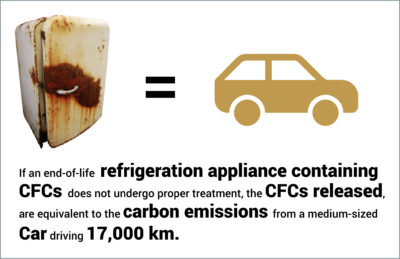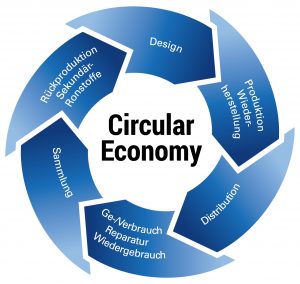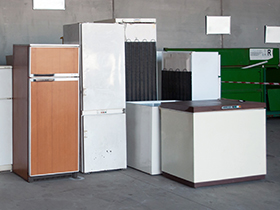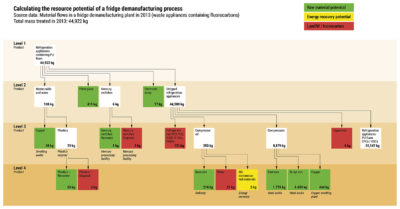Demanufacturing refrigeration equipment: A critical factor in attaining climate protection goals

Particular care and attention is required whenever environmentally problematic materials need to be handled as part of a waste management procedure. When refrigeration appliances have reached the end of their normal service life, treatment companies need to know how to manage the chlorofluorocarbons (CFCs) that are still present in many of these appliances. CFCs were first identified as playing a critical role in stratospheric ozone depletion back in the 1970s and they were the main driver behind the decision in the late 1980s to collect and treat waste refrigeration appliances separately from other waste electrical equipment. However, CFCs also contribute significantly to global greenhouse warming (see the ‘Fact and Figures’ page for more information on the role of CFCs in climate change).
The fact that the CFC refrigerant R12 found in waste refrigeration appliances has a global warning potential 10,200 times greater than CO2 demonstrates the huge environmental impact of these substances on the Earth’s climate. The CFC foam blowing agent R11, which was used to manufacture appliance insulation panels, has a carbon equivalence rating of 4660.
After the use of CFCs was banned, fridge manufacturers used hydrofluorocarbons (HFCs) as a replacement. While HFCs do not have an effect on ozone depletion, they still contribute significantly to the greenhouse effect. (The substitute HFC refrigerant R134a has a CO2 equivalence rating of 1300). The latest generation of refrigeration appliances that contain hydrocarbons (e.g. R600a in the appliance cooling circuit and pentane in the foam insulation) do not pose a direct threat to the Earth’s climate.
The Montreal Protocol on Substances that Deplete the Ozone Layer, which the EU implemented in its Regulation (EC) No 1005/2009 , effectively banned the production and use of CFCs, while the more recent Regulation (EU) No 517/2014 was introduced to control emissions from fluorinated greenhouse gases. Despite the introduction of such legislation the fact remains that:
The CFCs and HFCs still present in waste refrigeration equipment remain a major potential environmental hazard. Every gram of CFC released into the environment from waste fridges and freezers as a result of careless transport or improper treatment operations will attack the stratospheric ozone layer and/or contribute to global warming.
In Germany alone there a millions of refrigerators containing CFCs or HFCs that will eventually need to be treated. See also: RAL CO2OL-Print
Demanufacturing: Driving climate protection and advancing the circular economy
In addition to implementing measures to achieve global climate protection goals, another hugely important objective is to encourage and promote the reintroduction of recovered raw materials back into the materials supply chain. Of all the treatment regimes used to process waste electrical and electronic equipment (WEEE), fridge demanufacturing is the operation that most significantly contributes to realizing these goals.
The resource-potential method – Sustainability and the circular economy
With the inclusion of the resource-potential methodology in its quality assessment audit of fridge demanufacturing plants, RAL is breaking new ground in this area of WEEE treatment.

Traditionally, recycling facilities have been assessed in terms of recycling and recovery rates. In this conventional approach, only the material input streams of a recycling process are taken into account, i.e. the WEEE that is collected in local or municipal recycling centres or in take-back schemes and is then sent to recycling companies for treatment. The errors that arise from contamination of the input streams or from missorting in the input streams are not taken into account, with the result that apparent recovery rates of more than 90% are the rule rather than the exception.
In contrast, the resource-potential method, which was developed as part of a government-funded project in Luxembourg, focuses on the actual output materials from treatment plants, i.e. on the secondary raw materials generated at the end of the demanufacturing process. The result is an instrument with which demanufacturing plants can quantify the amounts of secondary raw materials effectively recovered as well as the fraction of waste used for energy recovery. And the resource-potential method offers consumers a way to clearly visualize the potential for saving primary resources.
The colour coding used to present the results is a simple traffic light system. Green corresponds to product reuse or recovery of secondary raw materials – the principal objectives of the demanufacturing process.
Amber (yellow) stands for energy recovery and red for landfill disposal, thermal destruction or loss.
Waste management and demanufacturing companies can have their treatment processes recognized if their services fulfil the quality specifications associated with ISO 14024-certified resource-potential method and additional performance audit criteria. Key audit criteria include full documentation of all the necessary permits and operating licences, complete transparency with respect to the material input and output streams, and clean and orderly operating premises.
An intentional side effect of applying the resource-potential method to the fridge recycling sector is that certification provides quantitative proof that the recycling and recovery rates prescribed in the European WEEE Directive and in the corresponding national implementing laws are being met.
The objective of the circular economy model is to create sustainable closed-loop supply chains that link traditional forward logistics (product manufacture > transport > retail > consumer) with the reverse logistics of product demanufacturing and the reintroduction of reclaimed raw materials back into the production process.
Demanufacture of refrigeration equipment

Quality-assured fridge demanufacturing has established itself as a standards-driven field in the waste management sector and is an outstanding example of applied reverse logistics.
At the centre of RAL’s demanufacturing methodology are our quality assurance and test specifications. Continuous and systematic monitoring ensures that waste management operations comply with these quality criteria and helps to drive both climate protection and implementation of the circular economy model.








